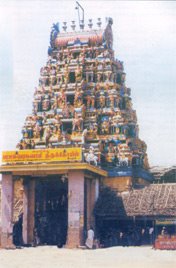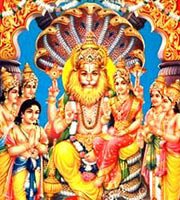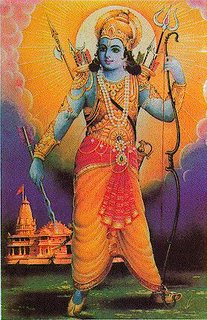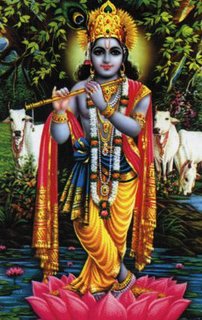 Sri Raghavendrar
Sri Raghavendrar
 Sri Raghavendra (1595 – 1671 A.D.) has a unique place in the lineage of Masters, because He is said to be still living in his ‘samAdhi’ at Mantralayam on the banks of the Tunga-bhadra river in South India. He voluntarily entered this samAdhi in 1671 A.D. and his disciples, on his orders built the structure of the samAdhi over his seated posture from which he left the mortal frame by his own will. He has declared that he will ‘live’ in this samAdhi’ for 700 years. It was God’s Will it seems that Sanku-karNa a close attendant-devotee of Lord Brahma the Creator Himself should be born repeatedly in this earthly world and be a great spiritual leader of humanity. Mantralaya was chosen by the Master as the right spot because the great devotee Prahlada had performed several ritual sacrifices here which makes the spot very auspicious. Also it was the same spot where Lord Rama once sat down in his historic wanderings through the forest .
Sri Raghavendra (1595 – 1671 A.D.) has a unique place in the lineage of Masters, because He is said to be still living in his ‘samAdhi’ at Mantralayam on the banks of the Tunga-bhadra river in South India. He voluntarily entered this samAdhi in 1671 A.D. and his disciples, on his orders built the structure of the samAdhi over his seated posture from which he left the mortal frame by his own will. He has declared that he will ‘live’ in this samAdhi’ for 700 years. It was God’s Will it seems that Sanku-karNa a close attendant-devotee of Lord Brahma the Creator Himself should be born repeatedly in this earthly world and be a great spiritual leader of humanity. Mantralaya was chosen by the Master as the right spot because the great devotee Prahlada had performed several ritual sacrifices here which makes the spot very auspicious. Also it was the same spot where Lord Rama once sat down in his historic wanderings through the forest .
The celestial Sanku-karNa was first born as Prahlada (in the very first manvantara), again as VibhIshaNa (Ravana's brother) in Rama’s time and again as vyAsa-tIrtha, the spiritual leader of the madhwa school in the 15th century A.D. This leader was the twelfth Pontiff of the Dvaita mutt known by his name. His contributions to the dvaita culture and philosophy and to the growth of the dvaita mutt were many. He establsihed 732 idols of Hanuman all over India. He was the guru of the Vijayanagara kings. He wrote valuable commentaries and propagated the madhwa philosophy very successfully. He initiated the gret devotee Purandara-dasa who was himself an Avatara of Narada the divine sage.
Then came the avatAra of Sri Raghavendra. Even as a youth Sri Raghavendra then known as Venkatanatha was not interested in worldly pursuits or a married life. The Goddess of Learning appeared before him in person and guided him to decide to throw away his worldly ties, his wife, his kith and kin, and adopt the ochre robe, which is what his own mind wanted. What followed was a long life of renunciation and dedication, ornamented by scores of miracles, several of which have been documented. He wrote more than forty works bearing on the teachings of Madhwa and the dvaita philosophy
In this avatAra Raghavendra captured the imagination of millions through his scholarship, devotion, spirituality, the divine qualities of infinite grace and compassion and his mystical powers of perception and action. It is said that his accumulated merit (= puNya) is so vast that as an enlightened soul he himself has no use for them. In his infinite compassion he lives still in his samAdhi and dispenses this vast store of puNya to those who care to visit his samAdhi or to worship Him and seek His grace. In fact this is the way he says he is helping his favourite God zri-Rama by relieving Him of His burden of removing the miseries of devotees, so that in the long run the devotees may ask from the Lord SrI Rama for the moksha that He alone can bestow. That is why He is thought of as the wish-yielding heavenly tree (= kalpa-vRkSa) or the divine Cow kAma-dhenu which both can bestow on you anything you want, just the moment it is wished. This thought is inbuilt into the following classical prayer traditionally addressed to Sri Raghavendra.
The words satya-dharma-ratAya ca are significant here. Truth (satya) and righteousness (dharma) are the two pillars on which the entire Hindu philosophy and religion stand. And of the two satya is more fundamental and is the one foundation for everything. satya has the top priority in Hindu dharma. It is independent of caste, creed, status of life, profession, tradition, lineage, race or sex. All other dharmas are dependent on satya. So the Ultimate is addressed as satya-dharma in the final prayer contained in verse 15 of ISopanishad: The face of Reality is hidden by the golden container. Reveal it, O Sun, so that I may visualise the Dharma of the Self as Truth. :
The Sun is the only physically visible representative of the Supreme Truth, Divine Light, brahman, in this earthly world - if we cannot see or visualise the whole universe as brahman itself. He is the One therefore, who illuminates us from within. Our limited consciousness has to open up to the Infinite Consciousness represented by the Sun. The allegory of the golden container in the above passage is full of meaning. The sanskrit word pAtra is derived from the definition: pIyate anena iti pAtram -- that by which we 'drink', i.e., experience. We experience the good and bad results of our past karma from this reservoir of our samskAra (store of cultural imprints in the mind) which brings forth our cycle of births and deaths.There are three seeds for this sprouting forth of our samskAras and vAsanAs. The three are: Light (cit), Existence (sat) and Love (Ananda). They respectively activate, our Intelligence from its state of ignorance and inertness, our Life (i.e., birth and death) from its state of formless subtlety and our Mind from its states of love and hate. These activations express themselves in our wish to know, our wish to live, and our wish to enjoy -- these three being in turn sustained by one's father through knowledge, one's mother through food, and one's spouse through pleasure and companionship. (For more on this go to Three fundamental urges ). This then is the whole cycle of our samsAra. The reervoir for all this is the golden container representing the reservoir of all our vAsanAs.The creator, BrahmA, through whom this blossoms in the world as Life, is called HiraNya-garbha (Golden Conception) in this charge of His. So the rays of the Sun which are golden in colour and which constitute the blinding factor for not allowing us to see the Sun, the Reality, constitute, as it were, the golden container of our vAsanAs. The only Seer is the HiraNya-garbha who sees it all through. Our individuality, our names and forms, our inner organ of mind with all its ramifications, its accessories in the form of our sense organs -- all these are created by this HiraNya-garbha, who gives the Light to all of them. He is therefore the savitA, the Sun. So we ask Him, plead with him and request him to remove the blinding rays from himself, because the seeds of our samskAras are with him, so that we can see Him as He really is. He is the One who can make us transcend our individuality and make us see the Oneness of Spirit within. This vision of the dharma of the Self as Truth is Sri Raghavendra.








